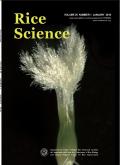OsCERK1 Interacts with OsHPP08 to Regulate Copper Uptake and Blast Resistance in Rice
IF 5.6
2区 农林科学
Q1 AGRONOMY
引用次数: 0
Abstract
The cell surface receptor chitin elicitor receptor kinase 1 (CERK1) is a well-known component of plant immunity. OsCERK1 is involved in regulating copper (Cu) uptake in rice, though the underlying mechanisms remain elusive. In this study, we identified proteins interacting with OsCERK1 and uncovered a novel heavy metal-associated domain-containing protein, OsHPP08. Our findings demonstrate that OsCERK1 phosphorylated and stabilized OsHPP08. Through structural analysis using AlphaFold, a yeast sensitivity assay of the Cu uptake-deficient yeast mutant, and Cu level measurements in oshpp08 mutants and overexpression plants (OsHPP08OE), we revealed that OsHPP08 facilitated Cu uptake. Additionally, rice seedling infection assays demonstrated that OsHPP08 positively contributed to blast resistance, with both OsCERK1 and OsHPP08 being essential for Cu-modulated blast resistance. Further analyses suggested that OsCERK1 and OsHPP08 likely enhanced blast resistance by regulating the antioxidant system and increasing H2O2 accumulation. In conclusion, OsCERK1 promoted Cu uptake by stabilizing OsHPP08, and together they contributed to Cu-modulated blast resistance, likely through the modulation of reactive oxygen species accumulation. These findings deepen our understanding of the intricate interplay between biotic and abiotic signals in rice.
OsCERK1与OsHPP08相互作用调控水稻对铜的吸收和稻瘟病抗性
细胞表面受体几丁质激发子受体激酶1 (CERK1)是植物免疫的一个众所周知的组成部分。OsCERK1参与调节水稻的铜(Cu)吸收,尽管潜在的机制尚不清楚。在这项研究中,我们发现了与OsCERK1相互作用的蛋白质,并发现了一种新的重金属相关结构域蛋白OsHPP08。我们的研究结果表明,OsCERK1磷酸化并稳定了OsHPP08。通过使用AlphaFold进行结构分析,酵母对铜摄取缺陷突变体的酵母敏感性试验,以及oshpp08突变体和过表达植物(OsHPP08OE)的铜水平测量,我们发现oshpp08促进了铜的摄取。此外,水稻幼苗感染试验表明,OsHPP08对稻瘟病抗性有积极的贡献,OsCERK1和OsHPP08对cu调节稻瘟病抗性都是必不可少的。进一步的分析表明,OsCERK1和OsHPP08可能通过调节抗氧化系统和增加H2O2积累来增强抗冲击性。综上所述,OsCERK1通过稳定OsHPP08来促进Cu的吸收,并且它们可能通过调节活性氧积累来共同促进Cu调控的抗爆性。这些发现加深了我们对水稻生物和非生物信号之间错综复杂的相互作用的理解。
本文章由计算机程序翻译,如有差异,请以英文原文为准。
求助全文
约1分钟内获得全文
求助全文
来源期刊

Rice Science
Agricultural and Biological Sciences-Agronomy and Crop Science
CiteScore
8.90
自引率
6.20%
发文量
55
审稿时长
40 weeks
期刊介绍:
Rice Science is an international research journal sponsored by China National Rice Research Institute. It publishes original research papers, review articles, as well as short communications on all aspects of rice sciences in English language. Some of the topics that may be included in each issue are: breeding and genetics, biotechnology, germplasm resources, crop management, pest management, physiology, soil and fertilizer management, ecology, cereal chemistry and post-harvest processing.
 求助内容:
求助内容: 应助结果提醒方式:
应助结果提醒方式:


